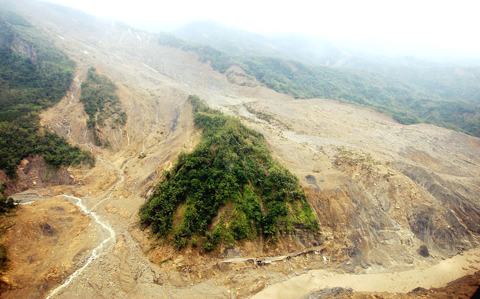The torrential rain brought by Typhoon Morakot, which killed hundreds and left hundreds missing, exposed crucial questions about environmental policies, flood control strategies and water resources management, experts said yesterday.
Flooding is a long-standing problem that endangers thousands during typhoon season.
The government has spent more than NT$500 billion (US$15.23 billion) on disaster prevention and construction of water conservancy infrastructure in the past 40 years, said Flood Management Watch, an alliance of civil environmental groups.

PHOTO: BEN YEH, AFP
The country remains highly vulnerable to flooding despite the NT$116 billion, Flood-Prone Area Management plan for 2006 to 2013.
The plan is also known as the “Eight-year, NT$80 billion” project, referring to the funding to improve rivers by the Water Resources Agency (WRA).
“We will only get into deeper water if we continue to stick with the traditional construction methods of flood control,” said Lin Sheng-feng (林盛豐), an associate professor of architecture at Shih Chien University, who served as minister without portfolio in the Democratic Progressive Party (DPP) government.
“Dramatic climate change will bring droughts and floods. When floods come, it is on a scale that levee structures can’t withstand, no matter how high their prevention standards,” Lin said.
CATASTROPHIC EVENTS
The dikes along tributaries of rivers are built to cope with once every 50-year flood events, while the standard embankment dams along main streams are built to withstand 100-year floods.
Last year, the country saw a once-in-200-year flood following Typhoon Kalmaegi, while the flooding caused by Morakot was close to a recurrence interval of 250 years, the Central Weather Bureau said.
Enacting legislation to restrict land use and reverse overdeveloped regions to environmentally healthier lands was crucial, Lin said.
The former DPP government proposed a draft restoration homeland act in December 2005, but the bill was never put onto the legislative agenda because of a Chinese Nationalist Party (KMT) boycott.
“The main principle in the draft was that ‘human beings cannot conquer nature,’” Lin said.
“In the past when the rainfall was small, humans used construction methods to overcome everything. Now, torrential rain has become part of our life,” Lin said.
“We have to acknowledge this fact and avoid disasters,” he said.
Lin said he met strong opposition when he tried to put the idea into action when he was in government.
“On several occasions after landslides and debris flows, we came up against a brick wall when we tried to convince residents not to rebuild roads in high-altitude areas,” he said.
Hsu Chan-shuan (徐嬋娟), who leads Flood Management Watch, which monitors the implementation of the “Eight-year, NT$80 billion project,” said the program should be suspended.
OVERHAUL NEEDED
“The government’s flood prevention system needs an overhaul because it uses the wrong approach of building up embankments and the like to prevent floods,” Hsu said.
The flooding brought by Morakot destroyed the embankments of the Laonong River (荖濃溪) in Kaohsiung County, the Taimali River (太麻里溪) in Taitung County, the Dajia river (大甲溪) in Taichung County and Niouchou River (牛稠溪) in Chiayi County, among others.
Destruction of river works has not only raised doubts about the effectiveness of such flood control measures, but also worsened the flooding. When dam failures occur, they create a total inundation as opposed to the gradual inundation caused by rainfall.
A major problem with the construction methods used is that they do not address the root cause of floods, Hsu said, citing Kaohsiung County’s Meinong River (美濃溪) as an example.
“The river floods whenever a typhoon comes. The flood management project begun 20 years ago is useless because the river failed to return to its upstream catchment areas, which have disappeared because of human activity. Instead, the project built dikes along downstream areas again and again,” she said.
Building up riverbanks or widening water courses are not the solution to flooding because the soil and water conservation efforts in upstream watershed areas have been seriously damaged, Hsu said.
“The Shuangxi River (雙溪) in Taipei County is another example. The river initially had a catchment area of 60 hectares, but this was cut in half for the construction of a freeway. When a river loses half of its catchment area, how can dikes prevent it from flooding?” she said.
“We human beings have long wrested land from nature bit by bit, and some day nature will take it all back, just as Morokot has done this time,” she said.
TOO MANY COOKS
The fact that a single river watershed district is managed by several agencies, each responsible for different sections of the river, also creates problems.
Rivers are classified into two categories in terms of management. The WRA is responsible for 24 major rivers, known as rivers administered by central government, while the other rivers and local drainage systems are under the jurisdiction of local governments.
The Council of Indigenous Peoples manages the portions of rivers that run through Aboriginal reservations, the Forestry Bureau manages those sections that pass through forestland and the National Property Administration administers any portions of a river going through its lands.
The Council of Agriculture’s Soil and Water Conservation Bureau (SWCB) is responsible for upstream tributaries, local governments and the Directorate General of Highways are in charge of roads on bridges and the bridges themselves, the Taiwan Joint Irrigation Association manages irrigation ditch systems and the Ministry of the Interior’s Construction and Planning Agency takes charge of storm sewage systems and surface runoff that enters the system.
Swing Huang (黃修文), a researcher at the Taiwan Environment Information Center, said this complicated management system has created an environment ruined by flood-prevention work.
It also means that these agencies shirk responsibility for the flooding problems, he said.
“It’s a fundamental mistake to separate a river into different management sections,” Huang said. “For example, the SWCB’s duty is to prevent landslides, while the WRA regulates the flow of a river. When the SWCB builds a sabo dam in upstream areas to prevent landslides, the work will lead to the shrinkage of the cross-section of the river channel, increasing sedimentation and the elevation of the river bed.”
“However, the SWCB doesn’t view these consequences as its responsibility,” Huang said.
The “Eight-year, NT$80 billion” project was earmarked for rivers administered by local governments and local regional drainage systems, while the fund for the 24 rivers managed by the central government is included in the government’s annual budget.
WRA Director-General Chen Shen-hsien (陳伸賢) said a few days ago that the flooding caused by Morakot was mainly due to the overflow of centrally administered rivers and not the rivers governed by local governments, which “proved the ‘Eight-year, NT$80 billion’ project was effective.”
Huang disagreed, saying that the flood-prevention construction projects were a failure.
As of last year, the total length of embankment along centrally administered rivers accounted for about 70 percent to 80 percent of the overall length of the sections of the rivers managed by the WRA.
Huang said that the funds appropriated to the WRA for managing rivers had been used to build dikes and channel water from one river watershed to another, a method often used in Taiwan to supply industrial water.
BLAME
One such current WRA project, building a diversion dam to channel water from the Laonong River in Kaohsiung County’s Jinhe Village (勤和村) to the Zengwun Reservoir (曾文水庫) in Tainan County, has been blamed by village council member Lu Chung-yi (呂仲珆) for the massive landslides in Kaohsiung County.
Ting Cheh-shyh (丁澈士), a professor of civil engineering at the National Pingtung University of Science and Technology, said that the extent of the recent flooding was both a natural disaster and also a human-made calamity.
“If the best strategy of returning land occupied by human beings to rivers cannot be used, the second best plan is to reforest bare areas, where ditches could be built to store floodwater or to build flood diversion works to mitigate floods. These two methods need to be included in flood prevention plans, aside from establishing dikes, which should be a last option,” Ting said.

Eight restaurants in Taiwan yesterday secured a one-star rating from the Michelin Guide Taiwan for the first time, while three one-star restaurants from last year’s edition were promoted to two stars. Forty-three restaurants were awarded one star this year, including 34 in Taipei, five in Taichung and four in Kaohsiung. Hosu (好嶼), Chuan Ya (川雅), Sushi Kajin (鮨嘉仁), aMaze (心宴), La Vie by Thomas Buhner, Yuan Yi (元一) and Frassi in Taipei and Front House (方蒔) in Kaohsiung received a one-star rating for the first time. Hosu is known for innovative Taiwanese dishes, while Chuan Ya serves Sichuan cuisine and aMaze specializes

Taitung County is to launch charter flights to Malaysia at the end of this year, after setting up flights to Vietnam and Thailand, the Taitung County Government said yesterday. The new charter flight services, provided by low-cost carrier Batik Air Malaysia, would be part of five-day tour packages for visits to Taitung County or Malaysia. The Batik Air charter flight, with about 200 seats, would take Malaysian tourists to Taitung on Dec. 30 and then at 12:35pm return to Kuala Lumpur with Taiwanese tourists. Another charter flight would bring the Taiwanese home on Jan. 3 next year, arriving at 5:30pm, before taking the

Taiwan High Speed Rail Corp. (THSRC) plans to ease strained capacity during peak hours by introducing new fare rules restricting passengers traveling without reserved seats in 2026, company Chairman Shih Che (史哲) said Wednesday. THSRC needs to tackle its capacity issue because there have been several occasions where passengers holding tickets with reserved seats did not make it onto their train in stations packed with individuals traveling without a reserved seat, Shih told reporters in a joint interview in Taipei. Non-reserved seats allow travelers maximum flexibility, but it has led to issues relating to quality of service and safety concerns, especially during

An exhibition celebrating Taiwan and Japan’s comic culture opened on Saturday in Taichung, featuring a section that explores Taiwanese reproductions of Japanese comics from when martial law limited Japanese representation. “A Century of Manga Culture: An Encounter of Taiwan and Japan’s Youth” held its Taiwan opening ceremony at Taichung’s National Taiwan Museum of Comics after an initial one-month run in Japan’s Kyoto International Manga Museum between May 24 and June 24. Much like the Kyoto exhibition, the show mainly celebrates the comic connection between Taiwan and Japan through late Taiwanese comic book